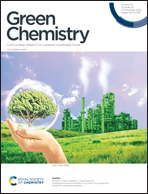Plasma-assisted nitrogen fixation: the effect of water presence†
Abstract
Electrification of the nitrogen fixation industry via plasma technology shows promising prospects to overcome growing environmental and economic shortcomings. The basic idea relies on using renewable energy sources and water to replace natural gas as the source of energy and hydrogen, thus, minimizing the tremendous CO2 footprint. However, the effect of water on plasma-assisted nitrogen fixation remains unclear in terms of the energy efficiency of the process. In this work, we investigate the efficiency of plasma-assisted nitrogen fixation toward NOx species production using two plasma systems. A “dry” pin-to-pin plasma is compared with a pin-to-liquid configuration, quantifying nitrogen-containing species in both gas and liquid phases, using infrared spectroscopy and ion chromatography, respectively. The main gaseous products detected in the systems are NO, NO2, HNO2, and N2O, while the liquid phase shows the presence of NO2− and NO3− ions. The main mechanisms of these species’ generation are illustrated, emphasizing the effect of the plasma/liquid interface. Particularly, the experiments with isopropanol used as a scavenger of OH radicals revealed that these radicals are responsible for ≈30% of the generated NOx−. Despite this, the presence of water in the reactive zone yet decreases the nitrogen fixation energy efficiency by ≈20% in comparison with nitrogen fixation in dry air. Among the possible reasons, the energy loss on water evaporation, the quenching of N2 excited states, and the less efficient extended Zeldovich mechanism are proposed and discussed.



 Please wait while we load your content...
Please wait while we load your content...